Duke and duchess meet Holocaust survivors in Poland
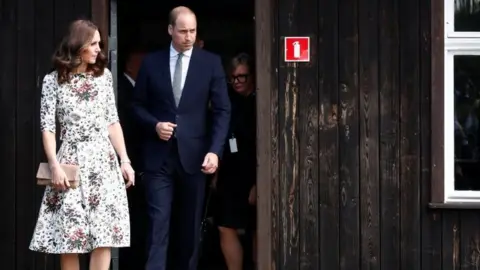 Reuters
ReutersThe Duke and Duchess of Cambridge have visited a former concentration camp as they continue their tour of Poland.
They described their visit to Stutthof as "shattering", saying the site is a "terrible reminder of the cost of war".
The royal couple met five Holocaust survivors at the camp near Gdansk, where 65,000 people were killed by the Nazis in World War Two.
The five-day tour of Poland and Germany will see the Cambridges also visit Berlin and Heidelberg.
Prince George, three, and Princess Charlotte, two, have accompanied their parents on the trip.
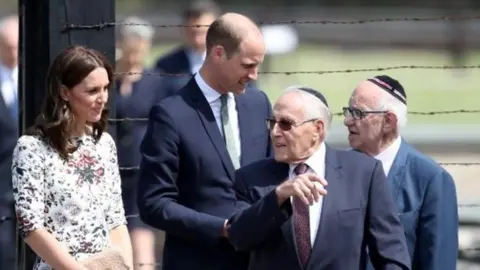 Getty Images
Getty ImagesDuring their visit to Stutthof, William and Catherine met British survivors Manfred Goldberg and Zigi Shipper, both 87.
As a teenager, Mr Goldberg spent more than eight months as a slave worker in Stutthof. There he met Mr Shipper, who had previously been at Auschwitz.
Days before the war ended, the camp was abandoned and prisoners were sent on a death march to the German town of Neustadt. The pair - both 15 at the time - were liberated at Neustadt on 3 May 1945. They later moved to the UK, where they remained friends.
Mr Goldberg said he was "extremely nervous" about returning to the camp, adding: "I agonised before I agreed to come here, because I felt I'd put it all behind me.
"In 1946 when I was a youngster I was admitted to England, I didn't dream I would ever have the privilege of shaking the hand of a future King of this country."
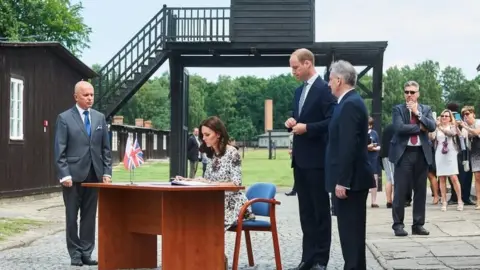 EPA
EPAA message left in the visitors' book, which both the duke and duchess signed, said: "We were intensely moved by our visit to Stutthof, which has been the scene of so much terrible pain, suffering and death.
"All of us have an overwhelming responsibility to make sure that we learn the lessons and that the horror of what happened is never forgotten and never repeated."
The royal couple then met Poland's first democratically-elected president, Lech Walesa, who won the Nobel Peace Prize in 1983 for leading Solidarity - the party that helped bring to an end communism in Poland.
Prince William and Catherine had a tour of the European Solidarity Centre, which represents the movement Mr Walesa championed, before laying roses at the Monument to the Fallen Shipyard Workers of 1970.
The memorial - made up of three 42m steel crosses - was unveiled in 1980, to commemorate the 44 people who died during anti-communist riots.

The Baltic death camp where thousands perished
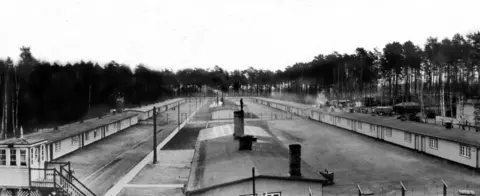
- Stutthof was the first Nazi camp set up outside German borders, established in September 1939
- It was originally used for the imprisonment of the Polish intelligentsia for "undesirable Polish elements"
- By 1942 it had become a concentration camp and grew to include 39 sub-camps which housed 110,000 men, women and children over its five years
- Some 65,000 inmates - which included 28,000 Jews - were killed by disease, malnutrition and execution by lethal injection, gas chamber, shooting and hanging
- Stutthof was the last camp to be liberated - on 9 May 1945 by the Soviet Army

In Germany later this week, Chancellor Angela Merkel will hold a private meeting with the royal couple in Berlin before they visit the city's famous landmark, the Brandenburg Gate.
The duke and duchess will also visit Berlin's Holocaust museum and memorial.
A boat race is planned in the German city of Heidelberg, which is twinned with Cambridge.
William and Catherine will cox opposing rowing teams in the race with crews from Cambridge and Heidelberg.
On the second day of the Polish leg of the tour, the royal couple joined a street party at Gdansk's central market square, where they were offered Goldwasser - a Gdansk liqueur - and traditional Polish pierogi dumplings.
They also visited the Gdansk Shakespeare theatre, opened in 2014, which has the Prince of Wales as patron.
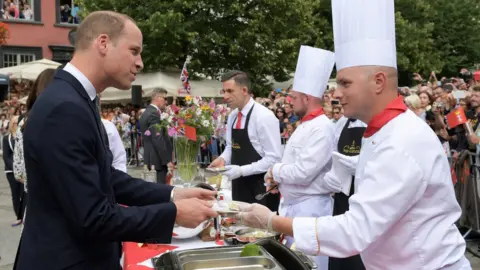 EPA
EPA Getty Images
Getty Images